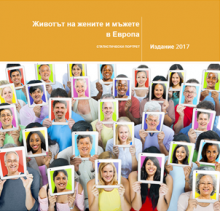Statistics can help to better understand the diversity and characteristics of the life of Europeans, by highlighting similarities and disparities between women and men. This is precisely the aim of the brand new digital publication ‘The life of women and men in Europe - a statistical portrait’, issued today by Eurostat, the statistical office of the European Union, in collaboration with the National Statistical Institutes of the EU Member States and the EFTA countries. This digital publication presents easily understandable statistics through short texts, graphs and interactive visualisation tools. Readers will also be able to test their knowledge in a quiz.
The publication, which is released on the European Statistics Day taking place each year on 20 October, is available for the first time in 24 languages.
The digital publication is divided into 3 parts:
• Living, growing, ageing…
This part focuses on demography and health, including for example data on life expectancy, household types or health perception. A lifeline highlighting different milestones in life is shown, where you can learn, among others, that women leave the parental home on average two years earlier than men in the EU ( 25 years vs. 27 years). You may also discover that there are seven times more single-mothers than single-fathers in the EU and that in general men are more likely than women to perceive their health as good. This part also shows that, despite their differences, women and men in the EU are similarly satisfied with their lives.
• Learning, working, earning…
This chapter includes data on education attainment, work-life balance, part-time work, unemployment, the gender pay gap, etc. Interesting findings here show that a higher proportion of women (33%) than men (29%) in the EU have a high education level. It also shows that the more children, the larger the difference between the employment rates of women and men. Furthermore, you will learn that women earn 16% less than men in the EU and that there are half as many women than men among managers.
• Eating, shopping, surfing, socialising…
This part focuses on nutrition and social habits, leisure activities and online practices. When looking at consumption of alcohol, cigarettes or fruit and vegetables, but also at physical activity, differences between women and men explain at least partly why there are more men than women in the EU considered overweight (57% vs. 44%). You will also discover that reading books as well as going to live performances, such as concerts, are more common among women than among men in the EU. A final section is dedicated to childcare, housework and cooking, where you will see, for instance, that 79% of women in the EU cook and/or do housework on a daily basis, compared with 34% of men.
Today's release of the Eurostat digital publication ‘The life of women and men in Europe - a statistical portrait’ is aligned with the opening of the high-level Power from Statistics" conference held over two days in Brussels.



